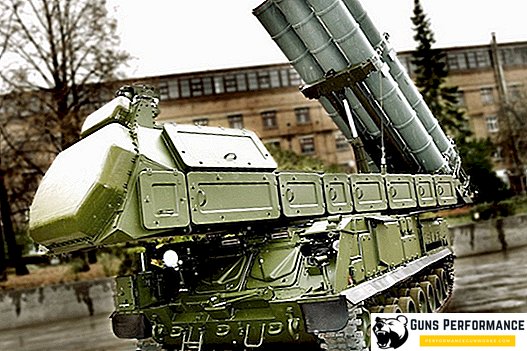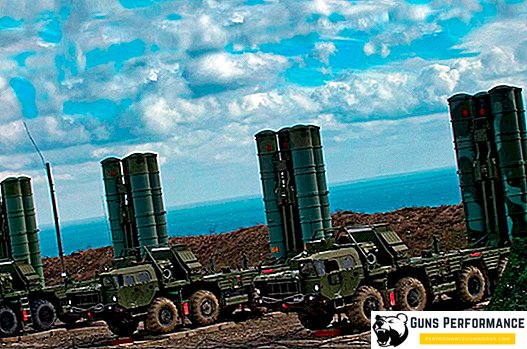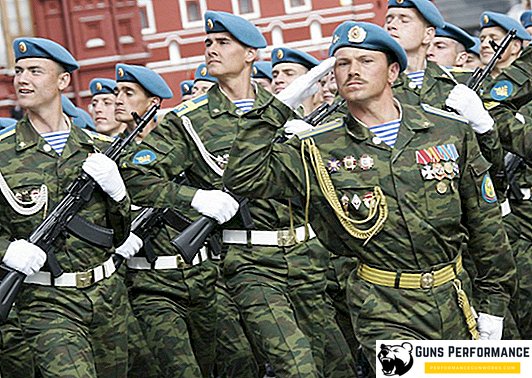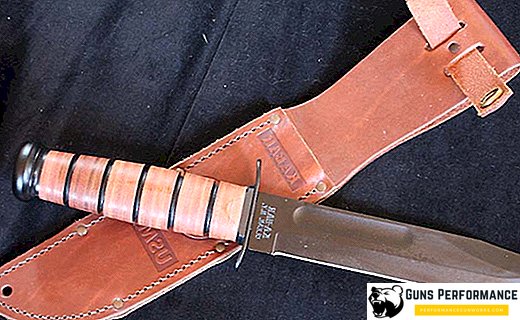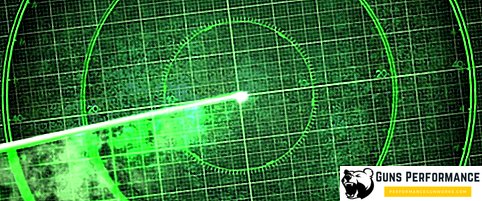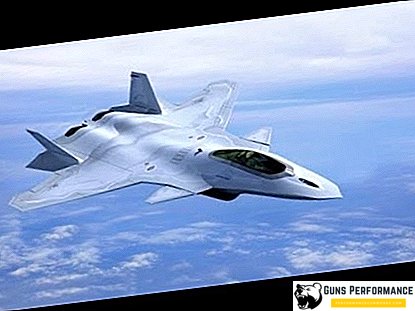If someone had the idea to hold a competition for the title of the most unusual aircraft, then the American bomber Northrop B-2 Spirit would definitely be among the winners. This plane is more like the current scenery of some fantastic Hollywood movie. However, despite its outlandish appearance, B-2 Spirit is a terrible weapon, because it was created to deliver nuclear strikes on cities and military targets of the enemy.
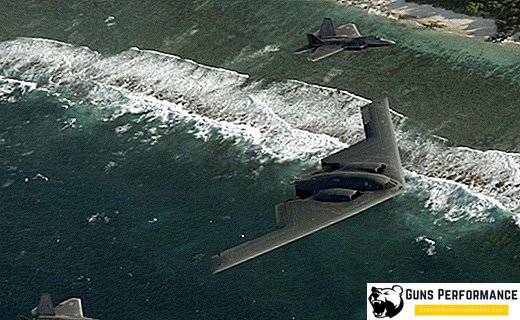
This plane went up to the sky at the very end of the Cold War, it was designed to break through the enemy's air defense system, and its unusual appearance provided it with maximum invisibility for enemy radar. But after a few years, the enemy, for the fight against which this aircraft was created, was gone, and the B-2 Spirit turned into an expensive wonder that caused American taxpayers much more damage than any enemy of the United States.
A bit of history
The prototype of modern strategic bombers are long-range bombers from the Second World War. The Americans and the British massively and effectively used heavy aircraft (B-17, B-24, Lancaster and B-29) to destroy the industrial potential of Germany and turn German cities into flaming ruins.

Strategic aviation gained new breath after the start of the nuclear era. Long-range bombers turned into strategic weapons and became one of the elements of the nuclear triad. Soviet and American "strategists" were on permanent duty, in the event of the start of Armageddon, they had to bring nuclear weapons to the enemy’s territory and strike at its targets.
The most massive strategic bombers of the Cold War were the Soviet Tu-95 and the American B-52 Stratofortress.
The improvement of strategic bombers proceeded in two directions: an increase in their speed and a decrease in radar visibility. The creators of the Tu-160 and B-1 went the first way, the Northrop B-2 Spirit became the embodiment of the second concept.
B-2 Spirit Development
The development of the B-2 Spirit began in the midst of the Cold War, in 1979. The program to create bombers with reduced radar visibility was called "Advanced Technology Bomber" (ATB). The giants of the American aerospace industry took part in it: Northrop, Boeing, Lockheed, Rockwell. The winner of the competition was the tropic Northrop and Boeing, and the design of the aircraft, on which they worked, received the designation B-2 Spirit.

The new bomber was created according to the "flying wing" scheme and its appearance was strikingly different from the American "strategists" B-1 and B-52. However, the history of the creation of aircraft with a similar scheme began for the company Northrop Corporation much earlier.
The founder of the company, Jack Northrop was an excellent aviation designer, he was still in the 20th of the last century, pondering the benefits that will receive aircraft made according to the "flying wing". Aircraft built according to this scheme have higher flight performance compared with conventional aircraft. A design without a fuselage and tail unit can provide an aircraft with an increase in payload, range and speed.
The designer was able to proceed to the practical implementation of his designs only after twenty years: in the early 40s, the US military became interested in creating a bomber with an intercontinental range. The first "flying wing" took to the air in 1946. However, it soon became clear that the level of development of technology in those years was not enough to solve the many problems that arose immediately after the machine began to operate. In 1948, the experimental aircraft crashed and after that the program was closed.
The concept of "invisible"
Only forty years later, aircraft designers returned to the idea of a "flying wing". Its creator, Jack Northrop, died in 1981, he did not see her embodiment in metal.

In addition to the obvious aerodynamic advantages that the use of this scheme gave, this design had another important advantage: low visibility for radars.
American pilots have experienced a real shock, having been in the "rocket jungle" of Vietnam. The consequence of this was the beginning of the program "Stealth", which was launched in 1965.
Its task was to reduce the radar visibility of aircraft and helicopters, the development went in two directions: the search for the airframe design, which would minimally reflect the signals of radars and the use of special radio absorbing materials. It soon became clear that to reduce radar visibility, the aircraft should not have protruding parts, its fuselage smoothly connected to the wings, and it is desirable to remove the keel altogether. Under this description of the aircraft is perfectly suited for the "flying wing".
B-2 belongs to the third generation of stealth aircraft. The first generation is the SR-71, the second is the F-117. This bomber can not be called completely invisible, but a significant reduction in the effective area of dispersion (EPR) makes this machine unobtrusive and significantly reduces its vulnerability.
The B-2 has no vertical tail, the glider has a rounded shape, there are no protruding parts: engines, weapons, fuel tanks - all of this is put inside the hull. Composite materials are widely used in the design of the aircraft, the body is covered with a special composition, which has the abbreviation RAM. It consists of several types of carbon fiber and has a high level of absorption of radio waves. The cockpit canopy is covered with a thin layer of gold, which helps to scatter radar signals and protects the crew from the light radiation of a nuclear explosion.

The exact ESR value of the B-2 bomber is classified, but it is considered to be 0.0014 m² to 0.1 m².
In addition, the designers took care of reducing the visibility of the aircraft in the thermal range: the jet streams of its engines are also shielded.
Cost vs. efficiency
Development of the aircraft lasted ten years and cost US taxpayers 22 billion dollars, plus another billion was spent on finalizing the machine. In 1988, the bomber was introduced to the public, and a year later the first flight of the machine took place.
Today, the Northrop B-2 Spirit is the most expensive aircraft in history. Taking into account the funds spent on its development, the cost of one machine is 2.1 billion dollars. The cost of its maintenance is also very impressive.
This machine was created for a nuclear war with the Soviet Union. The confrontation between the two nuclear superpowers, which we today call the Cold War, justified any military spending. However, even for this historical period, the cost of the B-2 looks clearly too high. Why did this happen?

The fact is that developing this super-expensive aircraft, the Americans thought to save. And there is no paradox.
According to the calculations of American strategists, a strong fighter escort (several dozen cars), several jamming aircraft (such as EF-111 "Raven") and F-4G aircraft were needed to overcome the Soviet air defense system, except for the bombers themselves. This air group must be accompanied by tanker aircraft (more than a dozen).
Eight F-117 stealth airplanes with the support of two refueling aircraft could strike at the same power.
The Americans hoped that the work that should have been performed by five or six dozen conventional aircraft, could be done only by two stealth aircraft B-2. Savings, as they say, there is.
In addition, representatives of the American military industrial complex told the public a lot about the possibility of creating a completely invisible and invulnerable aircraft. However, this is impossible in principle.
Ensuring stealth aircraft is very expensive and does not give a full guarantee of success. Very often, to achieve a lower level of visibility of the aircraft, designers have to sacrifice aircraft performance characteristics. Is this path a dead end? Expert opinions on this subject differ.

After the collapse of the USSR, the B-2 lost its only worthy opponent against whom it made sense to use this aircraft. There is no point in using this fabulously expensive and difficult to maintain aircraft in ordinary colonial disassembly. To defeat ground targets in the third world countries, the good old B-52 Stratofortress or just F-16 is quite enough.
A few words should be said about servicing the B-2. The cost of maintaining this aircraft is really high, they significantly exceed the funds that need to be spent on servicing other American strategists: B-1 and B-52.
B-2 Spirit needs a special hangar, with a constantly maintained microclimate. He is afraid of solar ultraviolet radiation, it damages the radio-absorbing coating of the aircraft body. In the world there are only a few air bases that are able to properly take care of this plane.
To date, 19 B-2 aircraft are in service.
Description of construction
Aircraft B-2 Spirit is made according to the scheme "flying wing", vertical tail is absent. The aircraft design is mostly made of titanium and aluminum alloys, and CFRPs with high heat resistance are also actively used.
The rudder functions are performed by splitting shields, which are mounted on the ends of the wing. On the rear edge of the wing there are three sections of elevons, as well as a deflected surface ("beaver tail"), which is located behind the center.

The machine is equipped with a three-bearing chassis, the main pillars have a cart with four wheels, and the front pillar has two.
The crew consists of two people. Entrance to the cockpit - through the front landing gear compartment.
The B-2 is equipped with four unforced engines, which are located along the edges of the central part of the body. Every two engines have one air intake with a saw-tooth leading edge and a curved channel, which excludes engine irradiation. To reduce the visibility of the nozzle are made flat.
The aircraft is equipped with a special system that cools the exhaust gases and reduces visibility in the infrared.
The B-2 Spirit is equipped with highly advanced avionics. The navigation system consists of an inertial unit associated with an astroinertial unit, there is the possibility of satellite navigation and communication with reconnaissance satellites. There are two multifunctional radar AN / APQ-118, they give the aircraft the opportunity to fly at low altitude with rounding of the terrain, can work in the mapping mode and scan the strip of the earth's surface with a width of 240 km. Also on the plane installed complex EW ZSR-62 and target designation equipment, which allows the use of high-precision ammunition.
In the course of modernization in 2010, the latest radar with an active phased array was installed on the bomber.

The armament is located in the central part of the body, in two compartments. After upgrading the aircraft bomb load increased to 27 tons. The B-2 can carry nuclear bombs, missiles with nuclear warheads, as well as conventional ammunition, including cruise missiles.
Application
The baptism of fire for B-2 was the war in Yugoslavia in 1999. Bombers dropped about 600 precision bombs. To participate in the fighting, these vehicles made a non-stop flight from their base in the United States to Kosovo and returned.
B-2 Spirit took part in the first and second conflicts in Iraq, attacked targets in Afghanistan, participated in an operation in Libya.
During all these conflicts, none of the bombers were shot down.
Specifications
Below are the flight performance of the machine.
| Modification | B-2 |
| Wingspan, m | 52.40 |
| Aircraft length, m | 20.90 |
| Airplane height, m | 5.45 |
| Bearing surface area, m2 | 464.50 |
| Weight, kg | |
| empty aircraft | 56700 |
| normal takeoff | 168435 |
| maximum take-off weight | 181500 |
| fuel (normal) | 73000 |
| fuel (maximum) | 81650 |
| engine's type | 4 General Electric F118-GE-100 turbofan engines |
| Thrust, kgf | 4 x 8600 |
| Maximum speed, km / h | |
| on high | 1010 |
| on the ground | 880 |
| Cruising speed, km / h | 850 |
| Practical range, km | |
| without refueling | 11100 |
| with one refueling | 18500 |
| Fighting radius, km | 5560 |
| Practical ceiling, m | 12500 |
| Crew | 2-3 |


